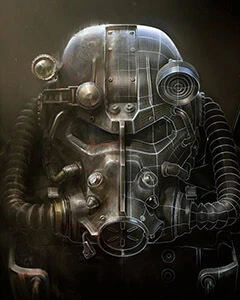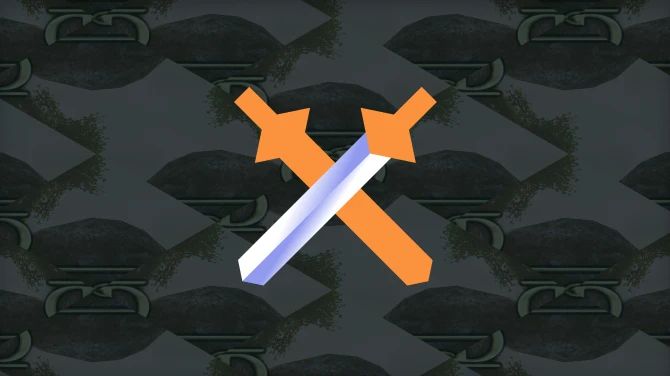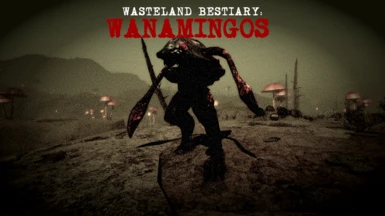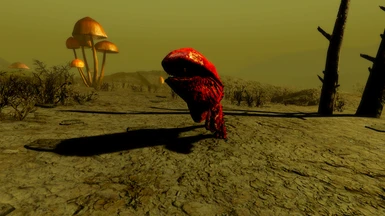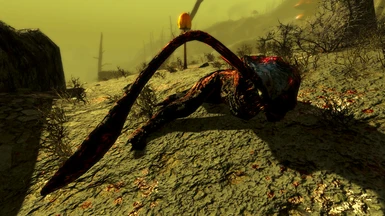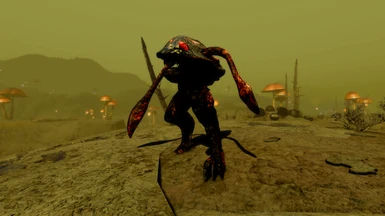About this mod
This light plugin adds the iconic, classic wanamingo to Fallout 4! Featuring simple integration, this lightweight mod should be unintrusive and compatible with just about any load order!
- Requirements
- Permissions and credits
- Donations
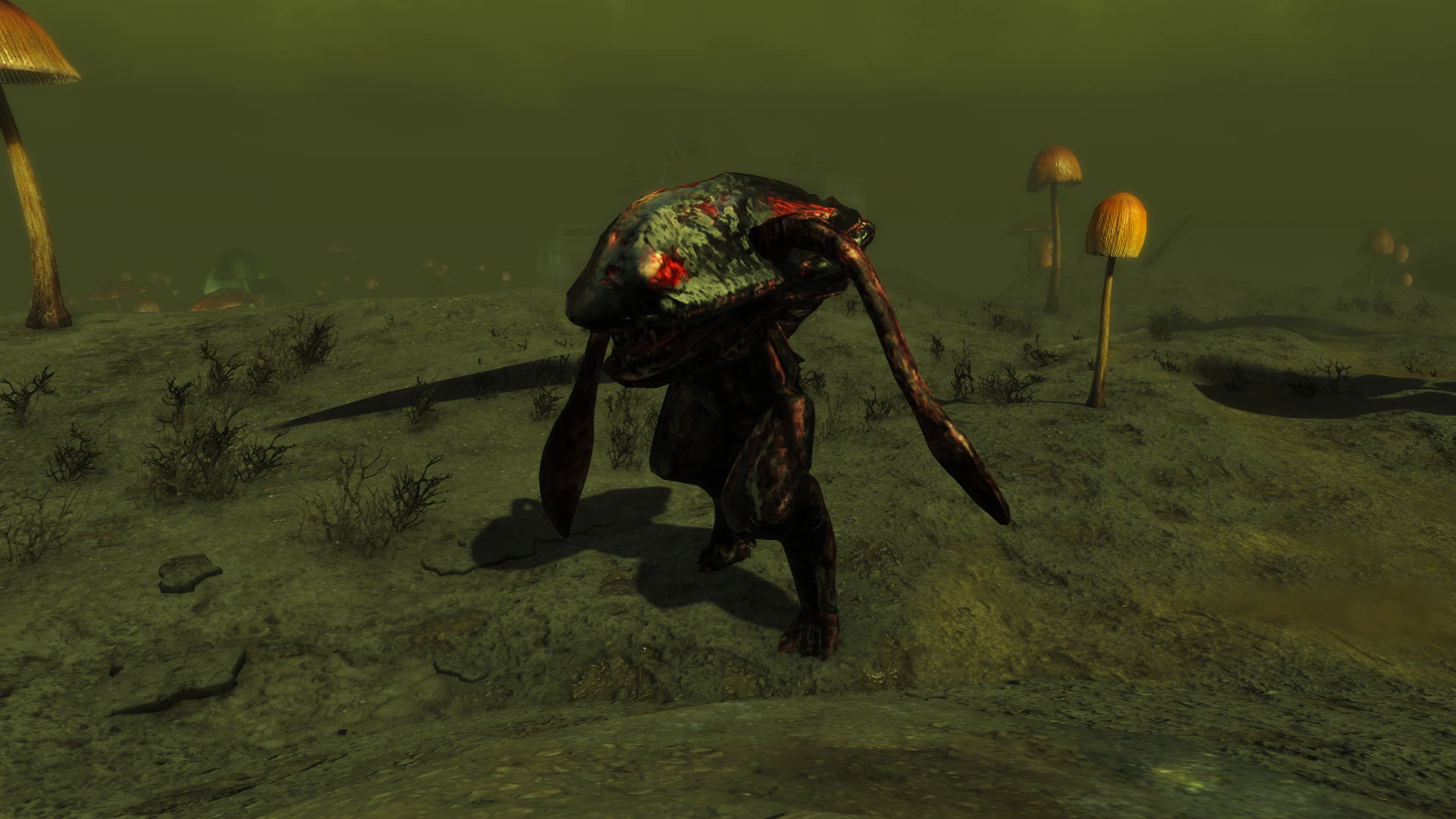
As seen in Mutant Menagerie: Life Finds A Way
"Since the Great War, legends spread across the wastes that alien and otherworldly horrors lurked in the deepest reaches of the world -- super predators on par with the mighty deathclaw. Largely referred to as "aliens" for decades following the apocalypse, this urban legend was finally given a name in Redding, California - about 40 years back. As the story goes there was a gold mine being operated by the locals known as the Great Wanamingo Mine. It was quite profitable for a time, until something big and particularly nasty decided to invade and infest the mine. Details here were scattered, but apparently the slaves working the mine (yeah, it was one of THOSE operations unfortunately) were forced to detonate their repository of dynamite just to escape. From that point on, the mine was closed off indefinitely. Reports on the exact appearance of the invading monsters were scattered and incongruent. Big, smelly, fangs, tentacles - those sorts of vague labels. It wasn't until anyone up to the task of actually clearing out the mine came along, that we'd get a clearer description.
Now, by this point the name "Wanamingo" was becoming the catchall for these creatures. The mine full of these killing machines was somehow (I assume using an unparalleled amount of firepower) cleared out by an individual I could only manage to identify as the 'Chosen One' - whatever that means. Regardless, In the aftermath, the corpses of these wanamingos were strewn about the mine. And, in the following days, this carrion was inspected by fellow academics, who discovered these particulars to be subjects of FEV experimentation. Not only that, but they theorized that these wanamingos were actually created before the Great War. Some of these scientists hypothesized that they had been engineered with a biological clock that would prevent further breeding beyond a specific generation. Unfortunately, this theory proved as preposterous in reality as it was on paper. In the following years, there was a serious effort by various specialists on the West Coast to hunt down any remaining wanamingos.
This effort by my predecessors yielded some very useful insight on the odd, alien wanamingos. The anatomy of these creatures was understood to be vaguely reptilian, but analogous to no living pre- or post-War animal. Rather, they are massive, bipedal, possess long tentacles instead of arms, and have a giant, flytrap-like mouth lined with teeth - itself encased in a protective, near-bulletproof shell. There are no eyes or sensory features visible on wanamingos, but their senses and faculties are not hindered in any way that implies sensory deprivation. They were described as hyper-aggressive and largely unintelligent. However, they were capable of some level of herd logic - or perhaps even a hivemind mentality.
The comparison to another famous wasteland titan is obvious here. Wanamingos share a lot in common with deathclaws. It's even believed that they may be part of the same program that spawned the deathclaw. It is entirely possible that wanamingos were biological weapons designed by the military or, perhaps, the Enclave. The physicality of the wanamingo certainly does resemble something that would be devastating in trench warfare, so I'm inclined to agree with such points-of-view. And while almost none of this 40-odd years-worth of research comes with a conclusive seal of finality, it sheds more light on these odd mutants than anything else we have.
In recent years, wanamingos have become rarer and rarer across the wasteland. Modern reports ascribe a number of mutations, anatomical variations, and adaptations. For example, there have been reports of "mutant wanamingos" that are able to thrive outside of their subterranean habitats - so long as visibility is low and terrential radioactivity is high. Some are said to have lost their trademark tentacles entirely, while others are said to have even more than is described in the old primary sources. There is a lot of speculation here, and I have done my own field research when I can, but these mutants are very hard to observe in any capacity that could be even remotely described as safe. They are still out there, though. I have seen them from a distance, and heard their haunting calls echoing out across the wastes. The more I investigate the curious case of the wanamingo, the more I find their original title to be far more fitting.
So, remember what you've learned here today. And, if you ever hear an otherworldly howl while exploring the darkest depths of the wasteland - run. Regroup, get your bearings, and then ask yourself a very important question: are you truly capable of confronting the terrors that may be lurking out there?"

What is this mod?
More of a mini-mod, Wasteland Bestiary - Wanamingos is a simple, standalone plugin that introduces a new creature to Fallout 4 with as efficiently as possible. Wasteland Bestiary is designed as series of mods that allows you to introduce new, lore-friendly creatures in simple, bite-sized chunks - with little impact on your game or load order. Very few worldspace edits and additions, a single script injector quest, and no additional systems. You get a creature, some new loot, a few new crafting recipes (including taxidermy), and a creature cage. All of it designed to meld with vanilla Fallout 4. If you were intrigued by all the creatures found in Mutant Menagerie, but didn't want all of the critters or all the additional bells and whistles, Wasteland Bestiary is for you!
What can I expect to find in this mod?
Wanamingos are nightmarish, alien monstrosities that lurk among the fringes of the wasteland. As seen in Fallout 2, wanamingos are dangerous creatures that share a similar origin to the mighty deathclaw. You'll find these nightmares lurking deep within the Glowing Sea - thanks to a select few hand placed spawns. There are many leveled variants of wendigos to encounter as well. Lastly, eagle-eyed wastelanders may also spot wanamingo nests dotted throughout the Glowing Sea, which can be looted for valuable rewards - such as wanamingo eggs!
And that's it. ESL-flagged ESP, BA2 archives, and well-optimized textures. Safe for just about any load order. Like I said, simple!

Lore-Friendliness Policy
Lore - "A body of traditions and knowledge on a subject or held by a particular group, typically passed from person to person by word of mouth." - OxfordLanguages Dictionary
"a particular body of knowledge or tradition" - Merriam Webster
Popular synonyms/similar words include: Mythology, Folklore, Backstory, History, Legends
What constitutes Lore-Friendly is something a lot of people are very, very opinionated about - often pointlessly so. I say pointlessly because Lore-Friendly (most-often) isn't a matter of opinion. Lore is backstory, legend, and history. Things are factually Lore-Friendly, and adhere to mythology and backstory, while other things are not, and contradict mythology and backstory. There is a line where conjecture and open-interpretation must be considered and a judgement call must be made, but that is very rare. The fact of the matter is, whether you like it or not, lore-friendliness is not up to the individual. The following criteria below are my rules for determining mod canon, and the criteria that I use to determine whether a creature is, in fact, lore-friendly:
1) The franchise owner/current-producer is the arbiter of canon.
If you own the rights to something, you have the sole right to define (or redefine) its canon and lore. For my mod, canon is defined by the one holding the keys to the kingdom. That means Bethesda is in charge - like it or not. If they say something is de-canonized, it is. If they make a retcon, that retcon is the new canon. If they add new information to the world, it must be considered and accepted - even the information that post-dates Fallout 4 (IE: Fallout 76). The minute you start picking and choosing what's canon based on which franchise variation's interpretation or presentation you liked better, that's the minute in which you lose any objective determination for what constitutes lore-friendly.
2) Something is either lore-friendly or it isn't. There is almost never an in-between.
Lore-friendly simply means that something doesn't contradict lore or break pre-existing canon. Period. It does not mean whether or not something is tonally or thematically consistent with the setting, or whether it breaks established conventions within franchise. Those are other issues entirely - ones that allow for the interjection of opinion and artistic interpretation. Whether or not something "works" in a fictional universe, from a worldbuilding standpoint or otherwise, is a very personal discussion that varies greatly based on who's doing the discussing. But none of those feelings or personal beliefs apply to the discussion of lore-friendliness.
The most frequent examples of such tonal debates being disguised as lore debates would be the discussion around artistic changes in the newer Fallouts. In the world of fictional universes, artistic interpretation and lore-friendliness are two separate discussions. You may not like the new power armor design or gameplay changes associated with it, but that argument does not belong in the lore-friendliness debate. Artistic interpretation is an accepted feature of the video game and wider entertainment industry - and especially so at Bethesda. It is important to respect that, rather than be distracted by it.
3) Pre-existing, canonized lore matters, but must be properly interpreted.
Jumping off from the first point, existing lore and canon make up the bulk of how we determine lore-friendliness. In a situation where canon on a topic exists, you must use critical thinking to analyze the information as it is presented. For example, In Fallout: New Vegas, Robert House states cats are extinct as part of a snide joke about skinning cats. If we didn't know what we knew post-Fallout 4, how would we analyze House's statement from a lore implicative perspective? Would we say that all cats in the franchise are extinct? Of course not, because how could Robert House possibly know that?
Without supporting evidence or affirmatory statements from others, the most that we could conclude concerning the cat question is the following. Either cats are either extinct worldwide, extinct in the American Southwest, or exist in such sparse numbers in the American Southwest that one of the smartest men in the world, with an incredibly advanced and well-established surveillance state, could be tricked into thinking they had died out. Since there is no definitive evidence or corroborating statements in-game to verify or dispute House's claim, we cannot call the existence of cats in, say, the Commonwealth, a canon-break from a logical standpoint. It is objectively lore-friendly given the context. We could, however, say that a sudden, healthy population of housecats in the Mojave Wasteland would be lore-breaking - given that it is within House's domain of influence. When in doubt, use the Socratic method.
4) If there is no information, it is a blank slate.
This may seem obvious to some, but it must be stated anyway. If no information exists on a subject, then it is an open book. If something isn't expanded upon in the existing canon, then any interpretation is objectively lore-friendly. If your fan project involves raccoons being extinct, and raccoons have never been mentioned in the history of Fallout franchise canon, then your project is lore-friendly. If your fan project features a mutant species of raccoon as one of its frontrunners, then again, your project is lore-friendly. No information doesn't mean you decide whether something's lore-friendly based on your feelings. Rather, this means that any interpretation of an untapped subject is lore-friendly. You are free to interpret such topics how you wish.
To take this a step farther, let's look at the radtoads from Mutant Menagerie. Radtoads are an established creature in Fallout 76, but their fate after the first 20-something years of the apocalypse is unknown in the lore. So, using the logic we just laid out, determining that radtoads may have mutated further into giant walking tanks 200 after Fallout 76 is a valid, lore-friendly interpretation. Deciding they remain unchanged, have gone extinct, or are entirely exclusive to Appalachia are ALSO a valid, lore-friendly interpretations. Do not waste time arguing about what isn't there. You'll live longer.
5) Cut or de-canonized content that hasn't been retconned or replaced is not law, but is still a valid interpretation.
This one is a little tricky, because it requires an understanding of the rules we laid out beforehand. Basically, if something, especially game content, has been declared non-canon, but has not been overwritten, it falls into the category of "valid interpretation". Elements of both Van Buren and Fallout Tactics, for example, have been canonized sparingly in later iterations of the franchise - despite both being separated from the lore by Bethesda. What this means is that while the content of something like, say, the Fallout Bible cannot be used to declare something non-canon, much of it (the bits that have not been overwritten or retconned) still represent valid, lore-friendly interpretations of certain subject matter. Even Bethesda still pulls from the Fallout Bible and other de-canonized material occasionally.
What this means is: while it may no longer be canon that wanamingos went extinct after Fallout 2 (as stated in the Fallout Bible,) and that information can no longer be evidenced to disprove their existence in future/fan material, if your fan project involves wanamingos going extinct as a major plot point, then that is a valid, lore-friendly interpretation of the Fallout universe. This is a very helpful rule for effectively utilizing supplemental materials that have live somewhere in-between canon and the dumpster.
6) Real-world logic matters when it does, and doesn't when it doesn't.
Fallout is one of those franchises where it takes logic and real-world inspiration incredibly seriously in some places, but is essentially a cartoon in others. For the sake of determining lore-friendliness, it's important to take into account when and where the franchise gets serious with its logic and where it gets goofy. Energy weapons, for example, are treated very cartoonishly and purposefully disobey the laws of physics and reality. Lasers can kick like a shotgun when fired because the universe isn't concerned with the realism of many of its more-pseudoscientific elements- it's more about the rule of retrofuturistic cool. Human issues, on the other hand, are usually treated realistically, with questions about politics, ethics, and the human condition being at the core of the Fallout franchise's writing and quest themes - and largely inspired by real events. This all borders very closely on the realm of "artistic interpretation" that we outlined in Rule 2, but uniquely has lore implications when it comes to certain elements of Fallout.
Creatures, specifically, tend to be taken quite seriously in Fallout. Outlandish designs aside, each creature tends to be consistent with a known real-world counterpart that fits ecologically within an environment. They usually have deep backgrounds, clear real-world and/or pop culture inspirations, and play crucial roles in their ecosystems outside of killing/fleeing from the player. Knowing that the franchise takes the topic of its creatures seriously, we could determine that lore-friendliness is strengthened when adhering to the ecology of real-world animals and creatures. Various exceptions do exist, however. This is primarily because pet stores, zoos, and wildlife sanctuaries exist - allowing for conjecture.
In summation, this is a rule that is best used for strengthening lore-friendliness and adherence to tone when creating, rather than declaring something to be lore-friendly or not. If your entire argument for declaring something a lore-break boils down to, "Its pre-War counterpart isn't native to this environment and climate," you are going to be very disappointed when, as a counterargument, your adversary submits a twenty-page backstory detailing a 200 year-long Galápagos tortoise migration - the ending of which outlines their colonization of Washington DC and their sudden turn to cannibalism. Is it ridiculous? Yes. Can you disprove it? No. Because tonally-inconsistent interpretations of the world are still, objectively, lore-friendly interpretations of the world. So long as they adhere to, and exist within the confines of, existing lore, everything's gravy. The correct description of this type of content is setting-inappropriate or tonally-inconsistent - not lore-unfriendly. Breaking the themes of a setting or its established tone is different from breaking its lore - IE mythos, history, and/or backstory.
Content Usage Policy and Distribution Permissions
The vast majority of assets used within this mod are publicly available under the CC4.0 Attribution license. Therefore, these assets are open for use and cannot be protected or withheld by myself (not that'd I'd ever want to - open source modding is the only way to properly mod in my opinion.) With that said, there are some licensed assets purchased from asset marketplaces, a few modders' resources, and some community contributions. There are even a few assets that were created by me - or modified from existing Bethesda assets.
Below is a comprehensive list of everything you need to know about asset usage with Mutant Menagerie. This is MY content policy only, for use with my mods, and must be used in conjunction with and adherence to Nexus's content policy.
1) REGARDING CREATIVE COMMONS ASSETS
All CC4.0 content is available for free use, and cannot be protected or restricted. This seems to be something of a point of confusion for users on the Nexus. Under the CC4.0 Attribution license, anyone can use, publish, modify, and profit from CC content - no permission needed - so long as proper attribution is applied. What this also means is that you MAY NOT, under any circumstance, restrict content that is derivative of or iterative upon CC4.0 content. When something is released into Creative Commons, you cannot take it out of Creative Commons. It doesn't matter if you edit the asset. It doesn't matter if you make it unrecognizable from its original form. If you build a house on Creative Commons' property, the CC owns that house - which means EVERYONE owns that house. What this means is:
- You may use all the assets in this mod that were released under CC4.0, no credit or permission needed, even if the assets were modified or altered from their source material. You can credit me if you choose, but I won't make a stink about it either way.
- You may not release a mod that denies or restricts others from using these assets, even if you modify or alter them.
- You must provide proper credit for the assets to the ORIGINAL creator, not myself, and must not imply in anyway that the original creator endorses your product or work if they have not explicitly done so.
Final Note: I've seen modders on Nexus take CC4.0 content, use it in mods, and then try to restrict the permissions of the mod and claim the assets belong to them. This is incorrect, this violates the CC4.0 license. See the above link yourself for more information. If I catch anyone doing this with any of the assets from my mod, I will personally report you. Creative Commons is an objective and unabashed good - the talented, selfless creators that contribute to it will not be disrespected on my watch.
2) REGARDING BETHESDA (FALLOUT 4) ASSETS
All Bethesda-based content is available for free, open use within the confines Fallout 4 modding, and cannot be protected or restricted. The assets provided to us for modding Fallout 4 by Bethesda do not - and cannot - belong to you. We are all free to use them, and we cannot legally restrict others from doing so. Nifbashed assets do not belong to you. Mesh/Texture edits do not belong to you. Modified vanilla scripts do not belong to you. If it is based off of Bethesda's existing work, you cannot claim the asset as your own. It belongs to the Bethesda and/or the artist, designer, or programmer on Bethesda's payroll that designed it. We are allowed to play with their toys and enjoy them - we are not allowed to claim them as our own and lock others out. What this means is:
- You may use all the assets in this or any mod that equate to modified, altered, or morphed Bethesda assets - so long as it adheres to Bethesda's modding and content policies. You do not need to ask for permission.
- You cannot claim you own any asset from Fallout 4, even if you modified it, and may not restrict others from using assets you do not legally own.
- You may not release a mod that restricts anyone from using a vanilla asset, even if was modified by you or someone else. It is not your property.
- You can modify and use any of the assets I've altered from their vanilla state - no credit or attribution needed. They weren't mine in the first place. They belong to the working-class designers and artists that helped bring Fallout 4 into reality. I don't want to steal credit they all deserve simply because I used Outfitstudio and GIMP to turn dogmeat into a coyote or a yao guai into a giant badger. The flexibility of the vanilla assets speaks to their talent, not mine.
- You may not convert any of these assets to work in other games - even if they have been modified beyond recognition. These assets were provided for Fallout 4 modding, you cannot legally remove them from this game and put them in another. The only time this cross-game asset usage is legal are under rare circumstances where multiple games are combined into a singular, combined release - IE Halo: the Master Chief Collection.
Final Note: I've seen people morph NIFs or make small texture edits, release them as mods, and restrict permissions on these assets. From what I understand, this is incorrect. You do not own those assets. These are commercial assets from a AAA game. They are yours to use, but they are not your property. I don't know what Nexus's position on this is, but there are mod authors on this platform that do this. If Nexus does find this acceptable behavior, that is their prerogative. But as far as I am concerned, you are only allowed to use my modified vanilla assets if you release your mod with open-permissions. Because sharing is an objective good.
3) REGARDING LICENSED ASSETS
All licensed assets purchased from asset marketplaces must also be purchased by any mod authors that seek to use them. Some of the assets within this mod were acquired via the purchase of a content usage license. These assets are legally mine to use, but they are not yours. I have the receipts to prove it - you do not. If you wish to use assets from this mod that are based on licensed assets, you may only do so AFTER you have also purchased the license yourself. Anything less is legally considered theft. And not Nexus-level mod theft, where there may be conjecture on who owns what and who can legally protect which asset, and wherein the biggest punishment you can face is having your mod deleted and your account banned. We are talking about easily provable, legally-punishable commercial asset theft. So buy the license - they're all relatively reasonable in price, I assure you. What this all means is:
- You cannot use a licensed asset without first purchasing the license for yourself. Violation of this simple rule is punishable by law. Someone may take legal action against you, and I am not responsible for it if they do. That's on you, my dude.
- You cannot release an addon for my mod that includes licensed assets, even if you require the main mod as a master. If you include these assets as loose files or in separate archives, you're committing a crime! This isn't something I have any involvement in either, it is between you and the artist on CGTrader you just stole from. So don't re-release those assets without purchasing the license yourself. No one can help you if you do.
- If you have purchased the license for these assets, all the versions of these assets from my mod are free to use. As long as you have paid the piper, you're free to use licensed assets from this mod - no permission needed. Just be sure to read over the asset license upon purchasing the asset for yourself, and ensure you do not violate it.
Final Note: Seriously guys, this is something that could get very bad if you aren't paying attention. Mod authors use licensed assets all the time, but we all purchase the licenses before doing so. If you just rip assets from this mod, assume it's okay to use, and then accidentally release the asset in a way that constitutes selling or redistributing the asset openly without a license, you could face legal ramifications! It's such an easy situation to avoid, so please ensure you do your research!
so you have NO excuse for misusing them!
4) RELEASING PATCHES/ADD-ONS
You may make add-ons for Mutant Menagerie, but you must release them with open-permissions. This mod is intended as a platform to move the community forward, as most big mods should be. In the spirit of that sentiment, you may not create add-ons, expansions, or patches for my mod if they are not also released as modders' resources. You must allow others to use the assets and content contained within freely, without having to ask permission, including use of assets in mods that earn Donation Points and the possible use of your mod in mod packs. Essentially, you must use an identical content policy to my original mod. Exceptions to this rule, of course, include licensed assets - like those mentioned above. What this means is:
- In order to release retextures, overhauls, patches, or other forms of add-on content, you must release them open-source. You may not restrict permissions or set options to "ask permission first." The only exceptions to this condition would be converting files to other games or mods being sold for money.
- If your add-on uses licensed content, you must link to those assets, in very much the same way as I have.
- I will not approve of any add-on content that isn't pro-sharing, pro-collections/mod packs, or pro-open source.
- You are allowed to earn Donation Points and donations from add-on content.
- You are NOT allowed to release add-on content to mirrors that are not BethesdaNet or Nexusmods, and you may NOT lock add-on content behind any sort of paywall.
- You may release translations, add-ons, and patches for Mutant Menagerie without asking for permission (obviously.)
Final Note: When it comes to my personal ethics, I very much possess a community-oriented 'everything should be public domain' view on modding (at least until actual mod marketplaces and career modding become a thing.) My policies will reflect that. I won't try to sway you one way or the other when it comes to your own content and pursuits. Everyone has their own views, and I'm not here to tell anyone those views are wrong. But with my mods, everything related to them will be done in the public domain.
5) MIRRORS AND ALTERNATE PLATFORMS
You may not reupload my mods on any alternative platform - they are only available on BethesdaNet and Nexusmods. If there is one thing I DO want full control over, it is WHERE my mod is distributed. If you see my mod on a platform other than the main two listed above, please report it. At the end of the day, this is something that is hard to police. Just know that if you come across my mod on other 3rd party websites, it isn't guaranteed to be safe to download, and doesn't support my work.
